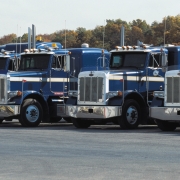
Calculating cost per mile (CPM) is one of the most common ways that carriers evaluate the financial success of their fleets. Calculating and tracking CPM consistently can give a carrier better insight into their overall costs and how to run their fleet more efficiently. Here’s how to calculate CPM and use it to better your fleet.
What is Cost Per Mile?
CPM is a simple metric that’s used to show how much each mile on the road is costing your carrier. An optimized fleet will attempt to maximize their CPM and reevaluate this number regularly so that they can continuously find ways to lower it.
Why Calculate Cost Per Mile?
Calculating and tracking CPM allows a carrier to see how efficiently its fleet is performing. CPM can also be used to inform the rate that you charge shippers. Profitable carriers have load rates that are (on average) higher than their CPM. Being confident in CPM allows carriers to better identify and reduce unnecessary costs while optimizing spending.
How do you Calculate CPM?
Fleets can calculate CPM by dividing their operating costs by the miles their trucks drive. To begin calculating this, you’ll need to first itemize your operating costs and evaluate your current truck mileage.
Operating costs include any cost associated with running your company. The three main operating costs are fixed costs, variable costs, and salaries. Because some of these costs will change frequently, your CPM will fluctuate. This is why reassessing CPM regularly is key. Tracking it monthly or quarterly is a good place to start.
Fixed Costs
As the name suggests, fixed costs are the consistent expenses that more or less stay the same month after month. You will incur these costs regardless of whether your trucks are running miles or sitting on a lot. Permits, insurance, and property lease payments are a few examples of common fixed costs.
Variable Costs
Variable costs will fluctuate over time, sometimes minimally, sometimes dramatically. Unlike fixed costs, variable costs are closely tied to how much you run your trucks. Diesel fuel, maintenance, food, and lodging are all variable costs. The more you run your trucks, the higher these costs will be, but that’s not necessarily a bad thing.
Driver Pay
In many ways, driver pay is a variable cost, but it deserves its own separate category because it has such a large impact on CPM. Typically, driver pay is one of the biggest recurring costs. Like other variable costs, the more miles that trucks run, the more the variable cost increases.
Becoming More Profitable
Once you’ve calculated your fleet’s CPM, you’ll probably be looking for ways to lower it. You can do that by either reducing your operating costs or increasing your fleet’s profitability.
Reduce Operating Costs
Calculating your CPM may have highlighted areas where operational costs could be cut. While cutting costs is usually thought of as a positive, think carefully before you decide whether and where to cut your budget.
Some decisions, such as decreasing driver salaries, may seem appealing because it can dramatically reduce your CPM. However, the long-term effects are likely to make things worse. A decision like this could lead to higher turnover, increased recruitment costs, and a poor company reputation.
Increase Gross Income
The other way to grow your company’s profitability is to increase income. Raising load rates is one way to do this. A higher load rate will mean better returns on your loads.
Another option is to run more miles. In this case, fixed costs stay the same, and variable costs are proportionally reduced. As a result, the CPM rate drops.
Understanding your carrier’s CPM will make financial decisions related to your fleet much easier to make. To be a top trucking company, analyze your CPM rate regularly to effectively respond to industry or fleet-based changes.















